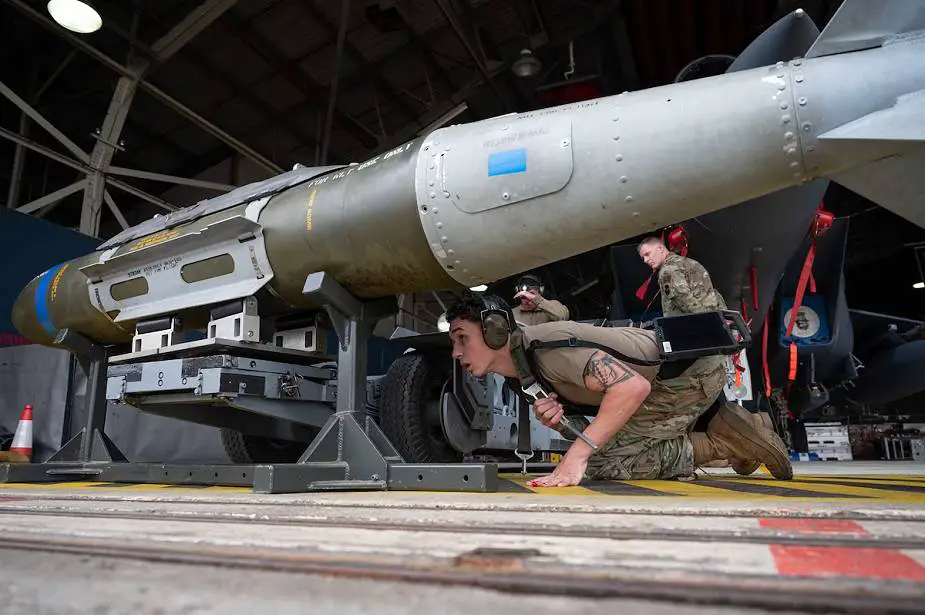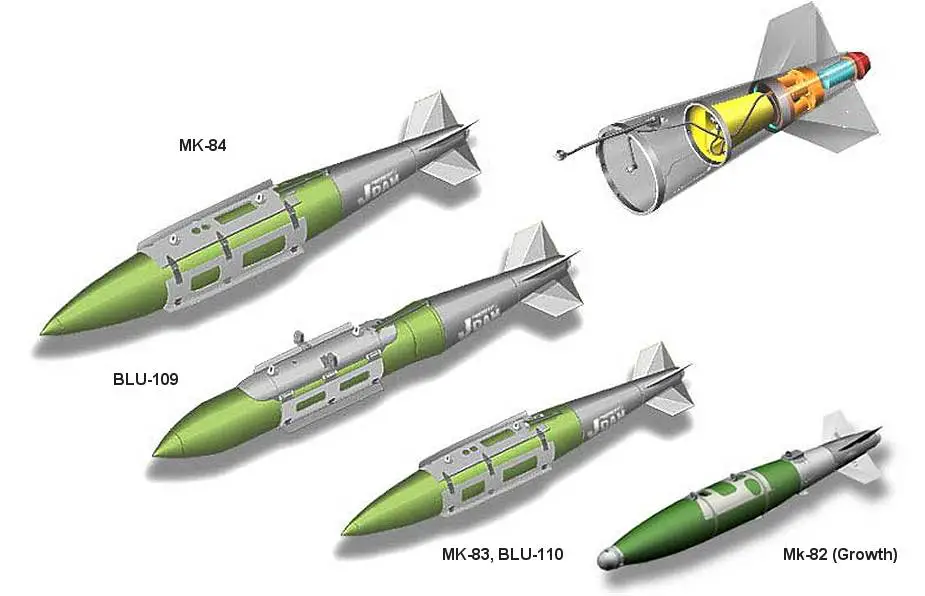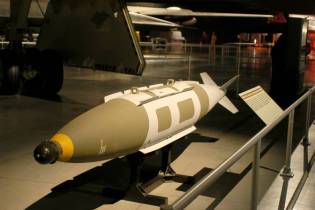- Army
- Air Defense Systems
- Anti-tank systems and vehicles
- Armored Vehicles
- Armoured personnel carriers
- Artillery Vehicles and Weapons
- Command Post
- Communication Vehicles and Systems
- Electronic Warfare
- Engineer | Maintenance Vehicles
- Infantry Fighting Vehicles
- Main Battle Tanks
- Missiles
- Tactical and Logistic Vehicles
- Radars
- Unmanned Systems
- Weapons
- Navy
- Air
JDAM JDAM-ER
JDAM & JDAM-ER Joint Direct Attack Munition Extended Range
Kit to convert unguided bombs to guided precision strike munition - United States

Description
The Joint Direct Attack Munition (JDAM) and JDAM-ER (Extended Range) serve as a guidance system, transforming unguided or "dumb" bombs into all-weather, precision-guided weaponry. This technology was collaboratively developed by the United States Air Force and the United States Navy. The initial delivery of JDAMs took place in 1997, followed by operational testing in 1998 and 1999. Over 450 JDAMs were deployed during these tests, showcasing an exceptional 95% system reliability and a 9.6-meter accuracy rate. Both the JDAM and the B-2 saw their first combat use in Operation Allied Force, a NATO-led military campaign conducted from March 24 to June 10, 1999, against the Federal Republic of Yugoslavia, which then consisted of Serbia and Montenegro. B-2 aircraft, undertaking 30-hour, nonstop roundtrip flights from Whiteman Air Force Base in Missouri, deployed over 600 JDAMs throughout the operation. At present, the JDAM is compatible with various aircraft, including the B-1B, B-2A, B-52H, AV-8B, F-15E, F/A-18C/D/E/F, F-16C/D, and F-22. Integration efforts are in progress or planned to assess its compatibility with the A-10, F-35 Joint Strike Fighter, and MQ-9 Reaper unmanned aerial vehicle. (Thanks to Chuck Pfarrer for the graphic in the details section). According to a picture released on August 23, 2023, by the Ukrainian Air Force, the JDAM-ER is now mounted on Russian-made Su-27 fighter jets.
JDAM Joint Direct Attack Munition variants:
- JDAM-ER: Joint Direct Attack Munition Extended Range is an upgraded version of the conventional JDAM, which provides extended range and improved accuracy for precision-guided munitions. The JDAM-ER features a wing kit that enhances the glide range, allowing the munition to be released from a greater distance, and thus reducing the risk to the aircraft and its crew.
Technical Data
| Design |
|
The JDAM is a kit that is added to a standard bomb that converts conventional, unguided bombs, or "dumb bombs," into precision-guided munitions. The kit consists of three main components including a tailed section, a strake kit, and the guidance control unit. The tail section includes stabilizing fins and a tail actuator system that controls the fins to steer the bomb towards the target. The fins provide aerodynamic stability and enable course corrections during the bomb's descent. The strake kit consists of aerodynamic surfaces that are attached to the bomb's body, further enhancing the bomb's stability and lift.
|
 |
| Warhead |
|
The JDAM kit can be mounted on a variety of general-purpose bombs, including the following widely used types:
- MK-80 series: This series of bombs comprises various sizes, including the MK-82 (226 kg), MK-83 (453 kg), and MK-84 (907 kg). These bombs are often used with the JDAM kit to create precision-guided munitions. The MK-80 series bombs contain conventional high-explosive warheads, which are designed for use against a wide range of targets, such as military installations, infrastructure, and enemy personnel. The warheads consist of a mixture of Tritonal, a high-explosive composed of TNT and aluminum powder, providing significant blast and fragmentation effects. - BLU series: The BLU (Bomb Live Unit) series includes the BLU-109 (907 kg) and BLU-110 (453 kg). These bombs have hardened casings designed to penetrate hardened targets and bunkers. When equipped with a JDAM kit, they become precision-guided bunker busters. The BLU-109 and BLU-110 bombs feature hardened penetration warheads, designed to penetrate hardened targets like bunkers, fortifications, or reinforced concrete structures before detonating. These warheads contain high-explosive fillers like AFX-757 or Tritonal, which create a powerful blast effect upon detonation, destroying the target from the inside. |
 |
| Guidance Systems |
| The Guidance and control unit (GCU) is the core of the JDAM system, containing an inertial navigation system (INS) and a global positioning system (GPS) receiver. The INS is a self-contained system that uses accelerometers and gyroscopes to track the bomb's position, velocity, and orientation. The INS calculates the bomb's trajectory based on the initial release information and continuously updates the flight path during its descent. The GPS receiver acquires signals from GPS satellites to determine the bomb's precise location in real-time. This accurate positioning data is essential for guiding the bomb towards the designated target. |
| Combat Use |
| The JDAM-equipped bombs can be used with a wide range of aircraft, such as the B-1B, B-2A, B-52H, AV-8B, F-15E, F/A-18C/D/E/F, F-16C/D, F-22, A-10, F-35 Joint Strike Fighter, and MQ-9 Reaper unmanned aerial vehicle. When a JDAM-equipped bomb is deployed, the aircraft's onboard systems transmit target coordinates to the bomb's guidance and control unit. Once released, the bomb uses its INS and GPS data to make continuous adjustments to its flight path, ensuring accurate delivery to the designated target. This results in significantly enhanced accuracy and effectiveness compared to conventional, unguided bombs. The combat use of JDAM (Joint Direct Attack Munition) significantly enhances the capabilities of military forces by providing them with precision-guided munitions that are accurate and effective in all weather conditions. With the integration of inertial navigation and GPS guidance systems, JDAM allows for highly accurate targeting, reducing the risk of collateral damage and increasing the effectiveness of strikes against enemy assets. JDAM-equipped bombs can be used effectively in adverse weather conditions, such as rain, fog, or low visibility. This feature ensures that critical missions can be executed regardless of weather limitations. The JDAM kit can be retrofitted to existing general-purpose bombs, making it a cost-effective way to upgrade the capabilities of a military's existing munitions inventory. can be employed in a wide range of mission types, including air-to-ground, maritime strike, and close air support operations. Its compatibility with various aircraft and bomb types further increases its versatility in combat scenarios. The enhanced accuracy and range of JDAM-equipped bombs allow aircraft to release munitions from a greater distance, reducing the risk of exposure to enemy air defenses. |
Specifications
| Type | Accuracy |
| Guided air-to-surface bomb | Specified 13 m; Realized around 7 m |
| Country users | Launch Weight |
| In service with 37 countries all over the world. | (JDAM and warhead) GBU-31 (v) 1/B: 925.4 kg; GBU-31 (v) 3/B: 961.4 kg; GBU-32 (v) 1/B: 460.5 kg; GBU-38: 253.6 kg |
| Designer Country | Ceiling |
| United States | 13,677 m (45,000-plus feet) |
| Guidance Systems | Range |
| GPS/INS | Up to 24;14 km (15 miles) |
| Wingspan | Length |
| GBU-31: 63.5 cm; GBU-32: 49.8 cm; GBU-38: 35.6 cm | (JDAM and warhead) GBU-31 (v) 1/B: 387.9 cm; GBU-31 (v) 3/B: 377.4 cm; GBU-32 (v) 1/B: 303.5 cm; GBU-38: 235.2 cm |
Details View
 |
|
 |
 |
 |
 |
Pictures - Video



























